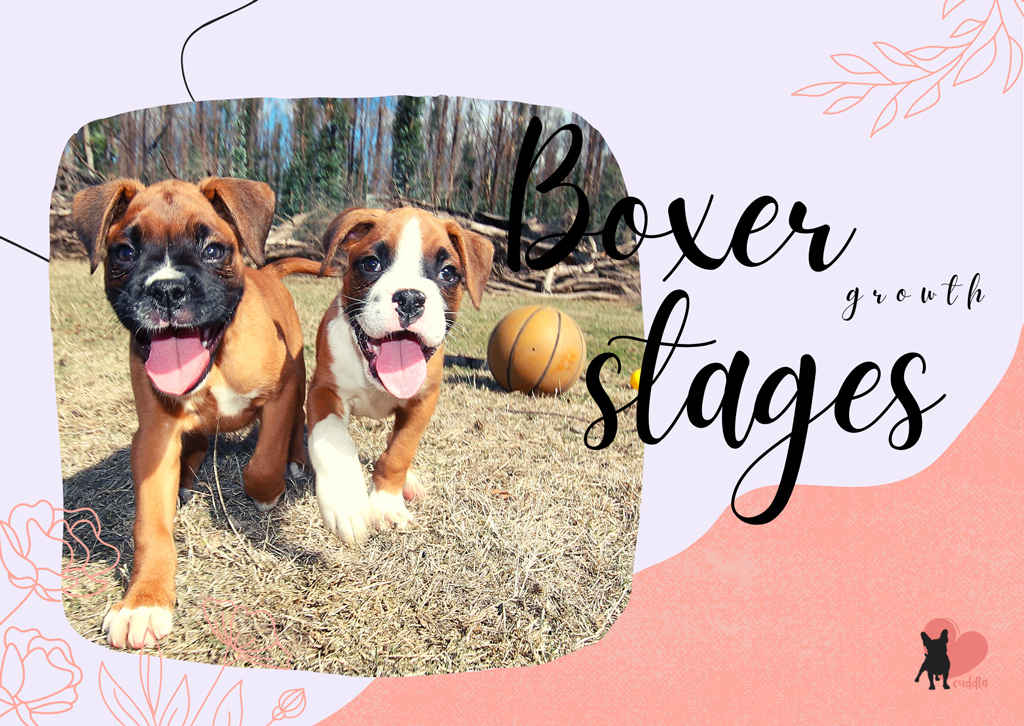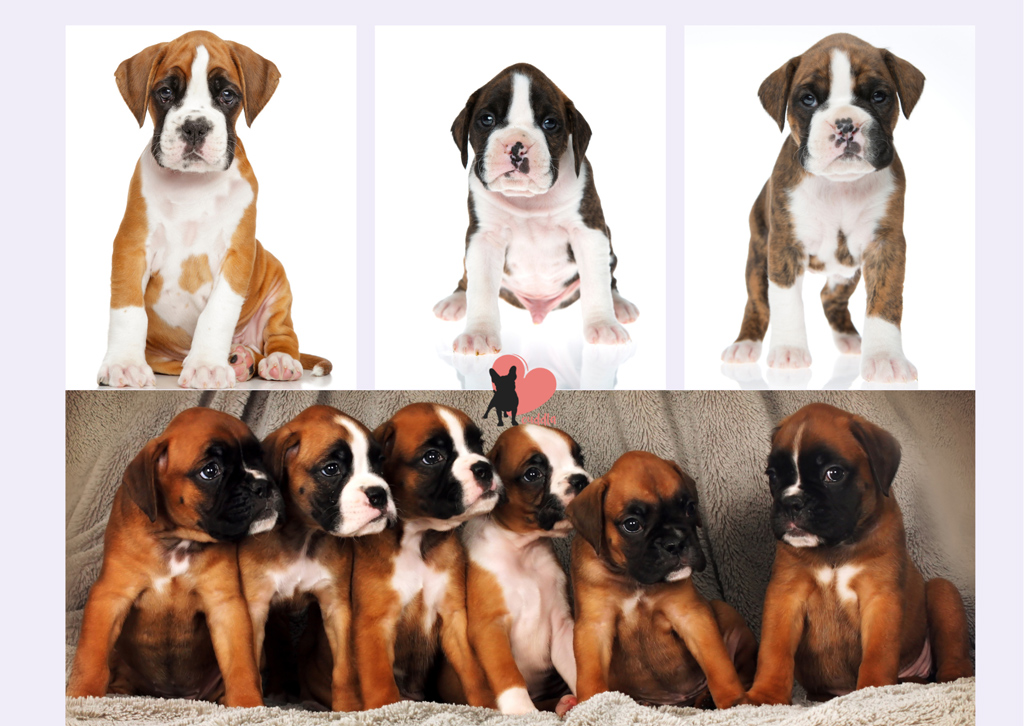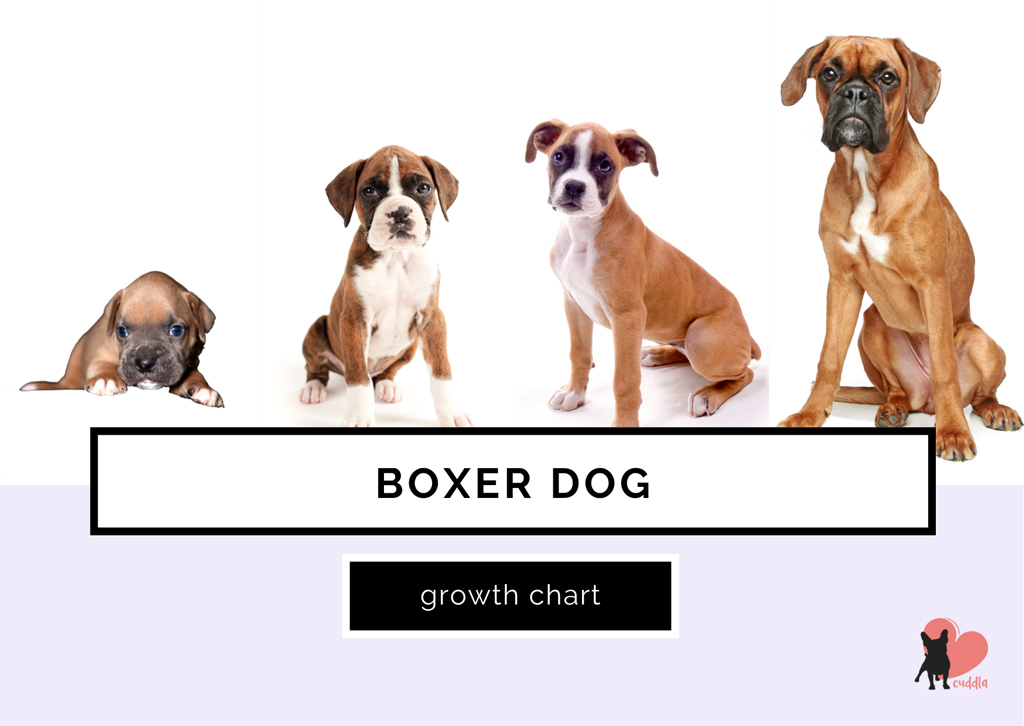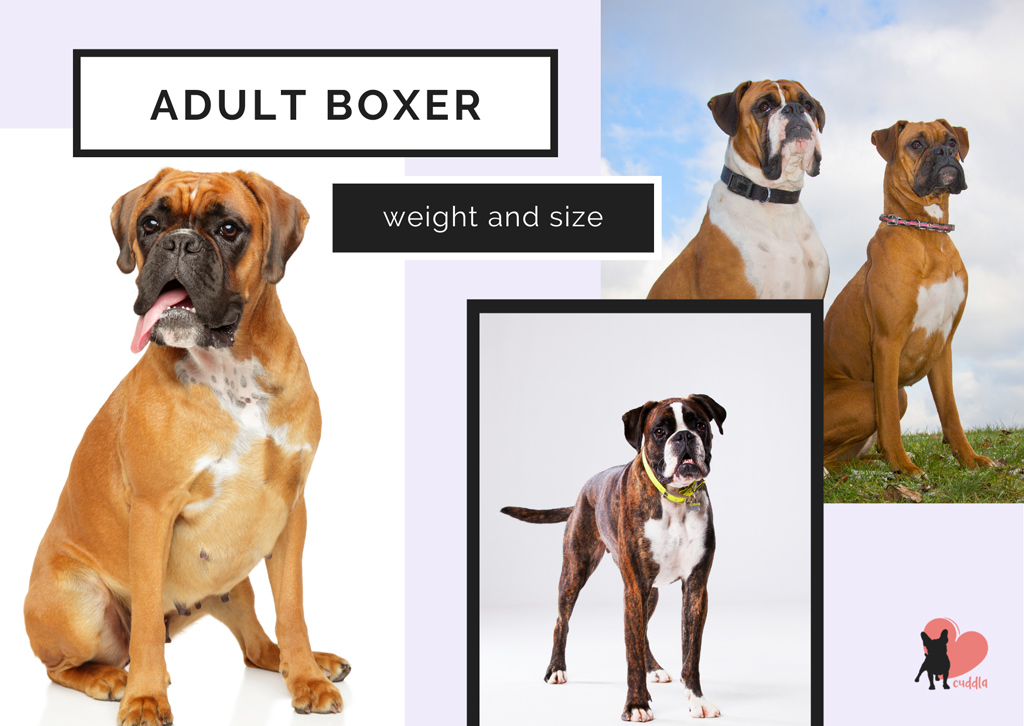
Whethere you’re thinking of getting a Boxer puppy or have one already, you will wonder about your Boxer’s development.
Even if you are familiar with dogs, you still want to know how big your Boxer is going to get, when and how long it takes for your dog to be full grown.
Your Boxer will go through 5 puppy growth stages:
- The neonatal stage: Birth to 2 weeks of age.
- The transitional stage: 2 to 4 weeks of age.
- The socialization stage: 3 to 12 weeks of age.
- The ranking stage: 3 to 6 months of age.
- The adolescence stage: 6 to 24 months of age.
Continue reading to find out more about your puppy’s development stages and have a look at Boxer’s growth size and weight chart.
Boxer Growth Stages
Boxers are considered to be a medium-sized dog breed and they belong to the Working group, which means they were bred to assist humans. Boxers have been known to carry out many jobs:
- Athlete.
- Cattle dog.
- Police dog.
- War dog in both world wars.
- Watchdog.
- Protection dog.
- And guide dog for the blind.
Even if Boxers are listed as part of the Brachycephalic breeds, which tend to give birth via cesarean, most Boxers are born naturally (unlike Boston Terriers, Pugs and French Bulldogs).
And what about the litter size; what is the average litter size for a boxer?
On average, Boxers’ have between 5 to 8 pups a litter.
Here’s what to expect for each of the 5 growth stages for the Boxer:

#1 – The Neonatal Stage (Birth to 2 Weeks)
During the neonatal stage:
- Puppies are blind, deaf, and toothless.
- Touch and taste are immediately present after birth.
- Their mother has the most influence over the puppy. She will feed them and keep them warm too.
- Puppies will mostly nurse and sleep during this stage.
#2 – The Transitional Stage (2 to 4 Weeks)
At the transitional stage:
- Their sense of hearing and smell will develop.
- Their eyes will open and will develop.
- Puppies teeth will begin to appear.
- Also, puppies will start to move. They begin to stand, take their first steps, wag their tail, and even bark.
- A puppy’s behaviour will be influenced by the mom and littermates.

#3 – The Socialization Stage (3 to 12 Weeks)
This stage is key for socialization, like the name indicates, and is the period when a puppy goes through rapid development.
During the socialization stage, the highlights are:
By 3 to 5 weeks, play becomes important as puppies become aware of their surroundings.
From weeks 3 to 4, pups develop control over their bladder and bowel movements. This is when they start learning to leave their sleeping area before relieving themselves.
From 4 to 6 weeks, puppies start learning dog social skills such as play, interaction with littermates, the inhibited bite, etc. Pups also explore their social boundaries, how to communicate effectively with other dogs and improve physical coordination.
From the 4th week, puppies begin forming emotional attachments and bonds with the people around them. A good time to meet your future pup. 🙂
By 5 to 7 weeks, a puppy needs positive human interaction as he or she develops curiosity and explores new experiences.
Between 6 to 8 weeks, puppies should start receiving vaccinations (source: American Kennel Club).
By week 8, puppies are fully weaned off their mother’s milk and eat solid food. After being fully weaned, pups start to be ready to leave their canine birth family and go to their new human homes.
By 7 to 9 weeks, puppies can begin to be housetrained, including potty training.
At 9 to 12 weeks, puppies can start learning basic commands as they start focusing on people (their new parents).
#4 – The Ranking Stage (3 to 6 Months)
At the ranking or pre-adolescence stage:
- Boxers start teething, so chew toys will become a household necessity. This process will last for several months.
- You are the main influencer for your pup.
- Keep up socializing and training your dog.
Insider Tip: Socialize your Boxer daily. Although the first 14 to 16 weeks of your puppy’s life can be considered to be your dog’s socialization period, it’s beneficial to keep exposing your pooch to new things. This is the best strategy to prevent future dog fears.
#5 – The Adolescence Stage (6 to 24 Months)
In general, smaller breeds mature sooner, while larger breeds can take longer to reach both physical and emotional maturity. Boxers, being a medium-sized breed, are somewhere in between.
You can still expect some puppy hijinks (playful, mischievous, or rowdy activity) and bursts of energy, especially since Boxers have a playful and athletic nature.
The adolescence stage is the last development step:
Between 6 to 12 months of age: Puppies reach sexual maturity, which comes before physical maturity.
- Female Boxers go into their first heat cycle (known as estrous) when they are 6 to 9 months old. After that, they are able to get pregnant.
- Male Boxers, however, generally gain full reproductive capabilities when they are between 6 to 12 months old.
Between 12 to 18 months of age: Some Boxers stop growing closer to 18 months, but many Boxers will continue to develop in weight and/or body size until they are two years old.
24 months old: Once they are 2 years old, Boxers are considered adults and reach their full height and weight.
From adulthood they will transition to seniors. A Boxer dog is considered to be a senior at the age of 7 or 8 years old. According to AKC’s breed standards, a Boxer’s life expectancy is between 10 – 12 years old.

Boxer Growth Chart
The rate of your Boxer’s growth can vary depending on your dog’s diet, genetics, exercise, and overall health.
This chart will give you a guideline for what to expect on how fast your Boxer grows and how quickly he or she will gain weight.
| BOXER AGE | BOXER HEIGHT | BOXER WEIGHT |
|---|---|---|
| 8 weeks | 7 inches (18 cm) | 13 – 18 pounds (6 – 8 kg) |
| 10 weeks | 10 inches (25 cm) | 22 – 24 pounds (10 – 11 kg) |
| 12 weeks (3 months) | 12 inches (30 cm) | 26 pounds (12 kg) |
| 4 months | 14 inches (36 cm) | 29 – 33 pounds (13 – 15 kg) |
| 5 months | 15 – 16 inches (38 – 41 cm) | 36 – 38 pounds (16 – 17 kg) |
| 6 months | 17 – 18 inches (43 – 46 cm) | 42 – 45 pounds (19 – 20 kg) |
| 7 months | 18 – 20 inches (46 – 51 cm) | 47 – 52 pounds (21 – 24 kg) |
| 8 months | 19 – 21 inches (48 – 53 cm) | 51 – 54 pounds (23 – 25 kg) |
| 9 months | 21 – 22 inches (53 – 56 cm) | 56 – 57 pounds (25 – 26 kg) |
| 10 months | 22 – 23 inches (56 – 58 cm) | 56 – 59 pounds (25 – 27 kg) |
| 12 months (1 year) | 23 – 24 inches (58 – 61 cm) | 57 – 63 pounds (26 – 29 kg) |
| 24 months (2 years) | 23 – 24 inches (58 – 61 cm) | 60 – 65 pounds (27 – 30 kg) |
You will notice that there is a range in both height and weight.
Use the lighter weights for female Boxers and the heavier weights for male Boxers. This principle also applies to the variations in heights. Females tend to weigh less and be smaller in size than males.
Boxer Development Stages FAQ
Here are some frequent questions about your Boxer’s development:
At What Age Is a Boxer No Longer a Puppy?
Between 6 – 12 months of age, Boxers are no longer considered puppies since they start to reach sexual maturity. Boxers are considered adolescents between 6 months to 24 months, and at 2 years old Boxers reach adulthood.
How Big Should a 6 Month Old Boxer Be?
On average, puppies have already reached 75% of their full height at the age of 6 months.
6 months old Boxers should weigh around 17 – 18 inches (43 – 46 cm) tall and weigh between 42 – 45 pounds (19 – 20 kg).
They will continue to grow until they are 18 to 24 months old.
At What Age Is a Boxer Full Grown?
How long does it take for a Boxer to be fully grown?
As a medium-sized dog breed, Boxers need more time to reach their full size and weight than smaller dog breeds.
On average, Boxers will grow until they are 18 to 24 months old. At 2 years old, Boxers are full-grown, reaching their full height and weight.
Why Is My Boxer So Skinny?
As with all other dog breeds, some adult Boxers will be smaller than the breed standards.
If your Boxer’s spine is very pronounced with little or no flesh on top of the individual vertebrae, or if the rib cage contours inward, your Boxer is likely underweight.
If that’s the case, take your dog to the vet as there could be an underlying problem. In the meantime provide quality food and regular exercise to ensure your dog’s good health.

Adult Boxer Average Size
Finally, you might be wondering… How much bigger will my Boxer get?
If your Boxer is less than two years old, he or she is likely still growing. Some Boxers stop growing closer to 18 months, but many Boxers will continue to develop in weight and/or body size until they are two years old.
Insider Tip: To estimate how big and heavy your Boxer will get, you can contact the breeder. Reputable breeders can give you a more accurate estimate based on previous litters and your dog’s parents’ exact height and weight. Puppies rarely exceed their parents weight and height.
Also, a DNA test (like Wisdom Panel 3.0 Canine DNA Test, available in Amazon) might be able to give you the same insight.
Let’s have a look at an adult Boxer size (both weight and height) and how to measure them at home!
Full-Grown Boxer Weight
According to AKC’s breed standards, females weigh about 15 pounds less than males.
Here is the average for a Boxer’s weight:
An adult female Boxer weighs between 50 – 65 pounds (23 – 30 kg) and an adult male Boxer weighs between 65 – 80 pounds (30 – 36 kg).
Boxers above this average may be classed over-weight. Check with your vet to get an accurate diagnosis since more athletic dogs will have bigger muscles and will weigh more.
It is important to recognize if your Boxer adds extra weight so that you can adjust his or her lifestyle.
Signs that your Boxer is overweight include you not being able to feel the ribs, your dog’s body not having definition and your pooch panting just after a few minutes of exercise.
You can read more about dog obesity at the How to Get Your Dog’s Weight Under Control blog post.
But, before taking any measures, it’s a good idea to take your dog to the vet’s office for a check-up.
Measuring a Boxer’s Weight
Whilst your Boxer is a pup, it’s quite easy to measure his or her weight using a home scale. If your puppy doesn’t stay still, you can always pick him up and weigh both of you. After, you just need to deduct your weight to find out how the weight of your Boxer.
However, the bigger they get, the trickier it gets for them to stand still on such a small scale. That’s why, as your pup gets bigger, you might need to go to the vet’s office.
Full-Grown Boxer Height
What is the size of a full-grown Boxer?
According to AKC’s breed standards, a male Boxer can stand as high as 25 inches at the shoulder, but females run smaller.
Here is the average for a Boxer’s height:
An adult female Boxer is between 21 – 23 inches (53 – 58 cm) tall and an adult male Boxer is between 23 – 25 inches (61 cm) tall.
Measuring a Boxer’s Height
You can measure your Boxer’s height with a measuring tape. Measure at the withers (shoulder) whilst standing.
Using the Dog Size Calculator
The puppy growth calculator is powered by Omni Calculator, and they couldn’t make it any simpler! All you need is to fill in your puppy’s age and weight (choosing the metrics of your choice), and the dog weight estimator will process these details of your puppy to its adult weight.
Your dog’s adult weight will then be displayed as a range e.g. 13 – 18 lb, also telling you what size type your dog will be and what they can measure up to in height, from paw to shoulder e.g. 18 in (45.7 cm) of height.
Try it out below:

